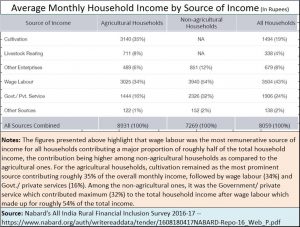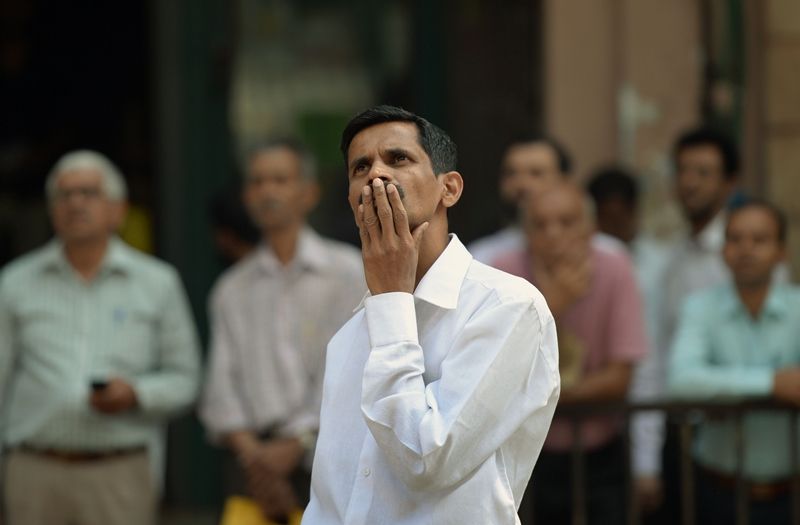http://www.freepressjournal.in/analysis/rural-incomes-worse-than-previously-imagined-r-n-bhaskar/1340980
The rural sector earns very little says Nabard
The latest Nabard survey on All India Rural Financial Inclusion Survey 2016-17 — https://www.nabard.org/auth/writereaddata/tender/1608180417NABARD-Repo-16_Web_P.pdf — points to a bigger farm crisis than had been imagined earlier.
 Just take a look at the figures alongside. They suggest that the average income from cultivation was just Rs.3,140 per household per month. This is pathetically low. What is worse is that livestock rearing generated only Rs.711 a month. That is even more terrible. This is because an average buffalo should yield at least five litres a day (going up to 15-30 litres daily). A mere change in cattle feed should help the yield per milch cattle go up from 2 litres to over 10 litres daily.
Just take a look at the figures alongside. They suggest that the average income from cultivation was just Rs.3,140 per household per month. This is pathetically low. What is worse is that livestock rearing generated only Rs.711 a month. That is even more terrible. This is because an average buffalo should yield at least five litres a day (going up to 15-30 litres daily). A mere change in cattle feed should help the yield per milch cattle go up from 2 litres to over 10 litres daily.
Even considering the lowest price for milk in the country – Rs.14 in Uttar Pradesh, which caused riots to spill over into the streets some years ago) – the average income cattle should be around Rs.140 a day for 300 days a year. Even assuming a flat rate of Rs.100 a day, the income from milk alone should have provided the rural household around Rs.3,000 every month instead of the measly Rs.711.
Clearly, the incidence of farm exploitation is far worse than had been imagined all along.
That is why it is galling to see the Maharashtra state government permit the state’s cooperatives to continue exploiting the farmers. Worse, it has actually gone about subsidizing this exploitation by agreeing to give farmer-milk-producers an additional Rs.5 per litre That translates into an annual bill of Rs.3,000 crore or more which the cooperatives ought to be paying, not the state..
Effectively, the state government burdened Maharashtra’s taxpayers with this additional sum. It is a price paid to bail out Maharashtra’s cooperatives which are mostly owned by the Congress and the NCP. These cooperatives are unwilling to pay more than Rs.20 a litre. They claim that they will make losses if they are compelled to pay more
In fact, talk of losses can be absurd. Remember Maharashtra State Cooperative Bank? It was making losses year after year. That was when Prithviraj Chauhan, the then chief minister of Maharashtra, agreed to banish the bank’s board of directors (though after being prodded by the RBI). The state appointed a fresh set of administrators. Lo and behold, the bank began making profits immediately thereafter.
If the state’s cooperatives refuse to pay the Rs.25/26 per litre, they too should have been taken over by the government and handed over to a new management – maybe to the NDDB – till a new competent management could be found to run these cooperatives efficiently. If Gujarat can pay milk producers over Rs.30 per litre, private players like Hatsun and Heritage can manage to pay over Rs.26 per litre, ditto for Karnataka and Madhya Pradesh, why should the state’s cooperatives be allowed to pay less?
That is when the Nabard figures begin to make sense. They show that the rot is not confined to Maharashtra alone. Throughout the country, India’s politicians have allowed structures to come up which ensure that the farmer is paid less, the consumers charged more, and the taxpayers burdened even further.
As the Nabard report shows, almost 20% of households “earned ₹ 2,500 or lesser per month which appears insufficient to meet the bare necessities of life. A sharp rise was seen in the households falling in the top 20th percentile, with income level rising from roughly ₹ 11,000 to ₹ 48,833 per month. The rise in income was much steep in the 99th percentile households which earned more than twice the ones in the 95th percentile and about four times the ones in the 80th percentile. These figures are reflective of wide income disparities in the rural communities with a very large divide between the rich and the poor. These disparities may be attributed to existing inequalities in terms of households’ ability to access various resources and opportunities which are essential for their development.”
The story is the same as for the rest of the Indian economy. The top 20% of people account for over 90% of the wealth in the country. The bottom 20% barely manages to survive.
It should have been different for agriculture and rural communities, since so much is spent by way of subsidies and doles, year after year; by government after government. It should certainly have been different for milk producers where a working model exists in Gujarat and where farmers get over Rs.30 per litre without state subsidies.
Maybe, it is time that the government stopped subsidies, and merely took over inefficient managers of supply chains and handed them over to NDDB or its equivalents against performance benchmarks. This exploitation has to stop.
This is certainly no way to govern.


































COMMENTS